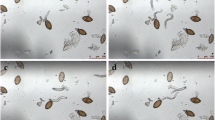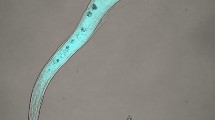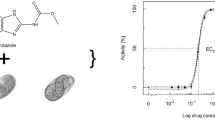Abstract
The development of Eucoleus böhmi eggs was evaluated in vitro in order to acquire information on the life cycle of this neglected respiratory nematode affecting canids. Fecal cultures were prepared using fecal samples from a positive dog and maintained at different conditions of temperature (20 ± 1 and 5 ± 1 °C) and relative humidity (RH) (85 ± 5 and 45 ± 5 %). Egg development was microscopically examined at days +7, +15, and +30. In addition, in order to assess the vitality of eggs maintained at 5 ± 1 °C for 30 days, these latter cultures were moved, placed at 20 ± 1 °C and 85 ± 5 % RH, and observed for further 30 and 40 days. The results showed that at 20 ± 1 °C and 85 ± 5 % RH, the totality of eggs completed development in 30 days, while about 26 and 70 % of eggs were already fully developed after 7 and 15 days, respectively. No egg development occurred after 30 days at 5 ± 1 °C, while 100 % of eggs placed at 5 ± 1 °C for 30 days and then moved at 20 ± 1 °C and 85 ± 5 % RH for further 40 days were found fully developed.


Similar content being viewed by others
References
Anderson RC (2000) Nematode parasites of vertebrates. Their development and transmission, 2nd edn. CABI Publishing, Guilford
Baan M, Kidder AC, Johnson SE, Sherding RG (2011) Rhinoscopic diagnosis of Eucoleus böhmi infection in a dog. J Am Anim Hosp Assoc 47:60–63
Boch J, Supperer R (1980) Parassitologia Clinica Veterinaria. 2nd Italian Edition. Editrice Essegivi, Piacenza
Campbell BG, Little MD (1991) Identification of the eggs of a nematode (Eucoleus boehmi) from the nasal mucosa of North American dogs. J Am Vet Med Assoc 198:1520–1523
Clark AC, López FR, Levine JM, Cooper JJ, Craig TM, Voges AK, Johnson MC, Porter BF (2013) Intracranial migration of Eucoleus (Capillaria) boehmi in a dog. J Small Anim Pract 54:99–103
Conboy G (2009) Helminth parasites of the canine and feline respiratory tract. Vet Clin N Am Small Anim Pract 39:1109–1126
Conboy G, Stewart T, O’Brien S (2013) Treatment of E. boehmi infection in a mixed-breed dog using milbemycin oxime. J Am Anim Hosp Assoc 49:204–209
De Liberato C, Mazzanti S, Scaramozzino P (2009) First report of Eucoleus böhmi in Italy. Parassitologia 51:43–45
Di Cesare A, Castagna G, Meloni S, Otranto D, Traversa D (2012) Mixed trichuroid infestation in a dog from Italy. Parasit Vectors 25:128. doi:10.1186/1756-3305-5-128
Gajewska A, Gorski P, Kotomski G, Bogdanowicz M, Klockiewicz M, Kazimierczak K (2004) Changes in parasites of dogs and cats from Warsaw and suburbs during the period of 1974–2002. Part III. Roundworms. Zycie Weterynaryjne 79:208–212
Gibbons LM (2010) Keys to the nematode parasites of vertebrates supplementary volume. Supplement to: CIH keys to the nematode parasites of vertebrates. In: RC Anderson, AG Chabaud, S Willmott (eds) 1974. CAB International, Wallinford, UK
Glantz SA (2003) Statistica per discipline biomediche 5th rev. Mc Graw-Hill, Milan
Henriksen SA, Korsholm H (1983) A method for culture and recovery of gastrointestinal strongyle larvae. Nord Vet Med 35:429–430
King RR, Greiner E, Ackerman N, Woodard JC (1990) Nasal capillariasis in a dog. J Am Anim Hosp Assoc 26:381–385
Magi M, Guardone L, Prati MC, Torracca B, Macchioni F (2012) First report of Eucoleus boehmi (syn. Capillaria boehmi) in dogs in north-western Italy, with scanning electron microscopy of the eggs. Parasite 19:433–435
Permin A, Hansen J (1998) The epidemiology, diagnosis and control of poultry parasites. In: FAO Animal Health Manual. FAO, Rome, Italy
Piperisova I, Neel JA, Tarigo J (2010) What is your diagnosis? Nasal discharge from a dog. Vet Clin Pathol 39:121–122
Schoning P, Dryden MW, Gabbert NH (1993) Identification of a nasal nematode (Eucoleus böhmi) in greyhounds. Vet Res Commun 17:277–281
Taylor MA, Coop RL, Wall RL (2007) Veterinary parasitology, 3rd edn. Blackwell Publishing Ltd., Oxford
Traversa D, Di Cesare A, Lia RP, Castagna G, Meloni S, Heine J, Strube K, Milillo P, Otranto D, Meckes O, Schaper R (2011) New insights into morphological and biological features of Capillaria aerophila (Trichocephalida, Trichuridae). Parasitol Res 109(Suppl 1):S97–S104
Veronesi F, Lepri E, Morganti G, Di Palma S, Mechelli L, Moretti A, Traversa D (2013) Nasal eucoleosis in a symptomatic dog from Italy. Vet Parasitol 195:187–191. doi:10.1016/j.vetpar.2013.01.022
Conflict of interest
The authors declare that they have no conflict of interest.
Author information
Authors and Affiliations
Corresponding author
Rights and permissions
About this article
Cite this article
Perrucci, S., Di Cesare, A. & Fichi, G. In vitro development of Eucoleus böhmi eggs in different environmental conditions. Parasitol Res 113, 2687–2691 (2014). https://doi.org/10.1007/s00436-014-3924-7
Received:
Accepted:
Published:
Issue Date:
DOI: https://doi.org/10.1007/s00436-014-3924-7




